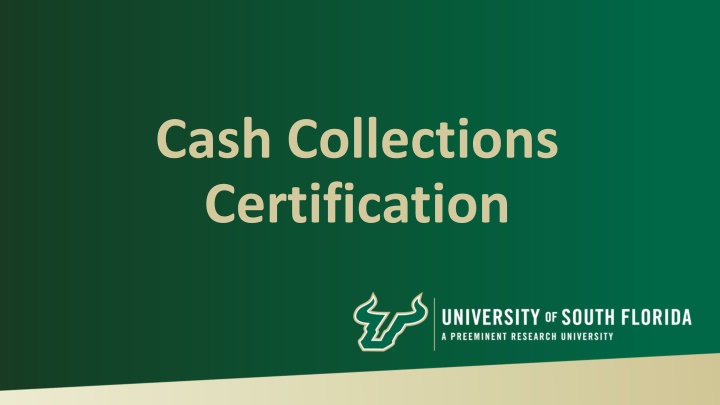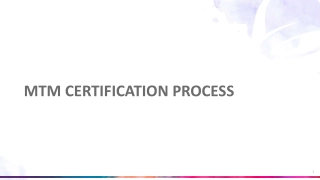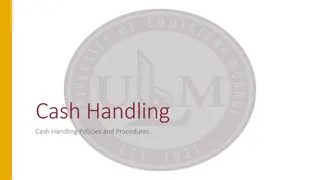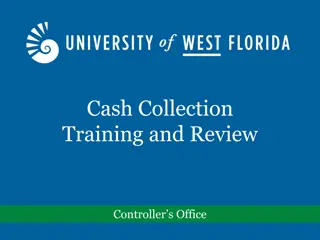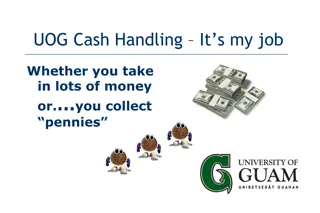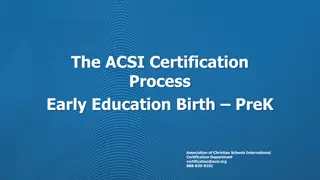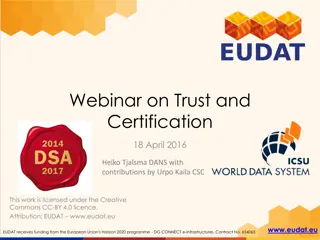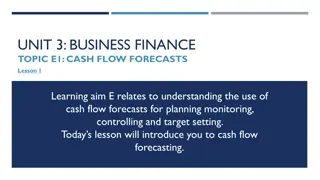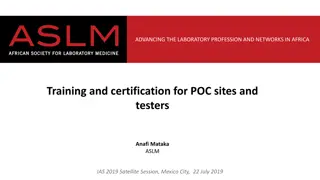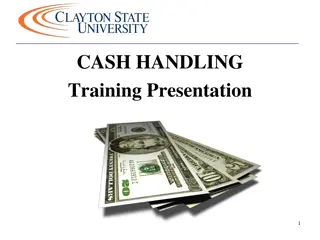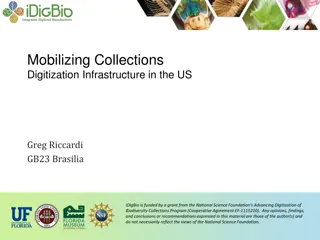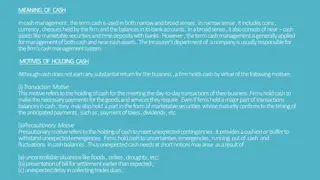Cash Collections Certification and Accountability Training
This training module focuses on Cash Collections Certification, accountability, and internal controls. It covers who needs to take the course, what constitutes cash, the importance of accountability, and the roles and responsibilities of individuals involved in cash handling processes.
Download Presentation

Please find below an Image/Link to download the presentation.
The content on the website is provided AS IS for your information and personal use only. It may not be sold, licensed, or shared on other websites without obtaining consent from the author.If you encounter any issues during the download, it is possible that the publisher has removed the file from their server.
You are allowed to download the files provided on this website for personal or commercial use, subject to the condition that they are used lawfully. All files are the property of their respective owners.
The content on the website is provided AS IS for your information and personal use only. It may not be sold, licensed, or shared on other websites without obtaining consent from the author.
E N D
Presentation Transcript
Cash Collections Certification
Who is required to take this course? Employees who have been identified as cash handlers Any department /unit / office that has been identified as an official cash collection area What happens next? Certification is required in order to serve as a cash handler at USF Complete this course Pass the Cash Collection Certification quiz with a 100% 2
Agenda The role of Accountability and Internal Controls Best practices in Cash Collections How to apply appropriate segregation of duties criteria The steps involved in the Cash Collection process at USF Four Functions of Segregation of Duties Record Keeping Authorization Custody Reconciliation 3
What is considered Cash? Currency and Coin Checks Credit Cards Money Orders Travelers Checks Electronic Funds 4
Accountability & Internal Controls Defining Accountability Internal Controls Examples
Defining Accountability The delegation of authority to qualified employees to: o Initiate, approve, process and review business transactions Holding these employees responsible for: o The validity, correctness and appropriateness of their actions 6
Accountability Everyone is accountable for their own actions Of all the individuals involved in the receipt, recording and balancing of funds is the person of ultimate responsibility as the custodian Payment processors are accountable for o Recording payments accurately o Observing all of the USF internal controls o Protecting the cardholder s information Supervisors are accountable for o Proper allocations of payments o Assignment of duties that comply with separation of duties guidelines Others are accountable for o Proper transfer of custody of payments Accountable officers are ultimately responsible for payment transactions 7
Internal Controls Design to protect: o USF o USF staff Are designed to provide reasonable assurance regarding: o Effectiveness and efficiency of operations o Reliability of reporting o Compliance with applicable rules, laws, and regulations 8
Internal Controls as they relate to Cash Management Internal controls specifically ensure: o The safety of all funds o Timeliness of recording the receipt of all funds o That the assignment of duties complies with separation of duties guidelines o Reconciliations are completed and reviewed on a monthly schedule o A sound audit trail and adequate documentation are created 9
Internal Controls - Examples Access to credit card terminals and POS systems must be limited to a primary and a secondary custodian Physical safety of the information and equipment must be ensured at point of collection and then stored overnight All adjustments must be documented and approved by a supervisor (authorizer) Transfers of funds must be documented o When handed from one person to another o When delivered to the Cashier Office Cashiers must balance the funds they collect to the system where the payments were recorded Funds must be deposited in a timely manner o Deposit whenever funds are greater than $500 or within five business days, whichever comes first Deposits must be reconciled to the general ledger 10
Internal Controls Examples (continued) When funds are initially received, the event must be documented in one of the following ways: o Mail logs o Cash receipt slips o Cash registers o Credit card system o An enterprise business system (e.g. FAST or OASIS) 11
Internal Controls A real life example Rocky the Bull, a USF student, arrives at the bookstore to purchase 6 books for his upcoming Spring semester. Informing the cashier of his upcoming classes, the cashier then looks up the books he needs for each class. Rocky then purchases all the books retrieved by the cashier for his classes. After paying for all 6 books, Rocky reviews his receipt and realizes that all the books were charged incorrectly. He returns back to the cashier, who then calls their supervisor to void the receipt and charge the correct price for all the books. Rocky leaves the bookstore, with all his books for the correct price, excited and ready for the new semester. What did you notice? A list was used for inventory and pricing control Rocky paid the cashier; no one else could accept payment Rocky was given a receipt The cashier had to deliver the product to Rocky (prevents theft and customer errors) A supervisor had to make the corrections; they acted as an authorizer 12
Segregation of Duties Defining Segregation of Duties The Four Functions of Segregation of Duties Record Keeping Authorization Custody Reconciliation When Segregation is not possible Examples
Segregation of Duties Separation of duties protects USF and the individual by ensuring that no one person has the ability to control all of the steps involved in handling and accounting for money received by USF. Record Keeping Authorization The idea is that any one person performs only one function; four people are needed for the four functions. Reconciliation Custody 14
When segregation is not possible If one person performs two or more of the functions: oRisk exists that presents the opportunity for something to go wrong oA compensating control is needed to reduce the risk oThe compensating control might be an extra layer of review Provide mitigating or compensating controls Design additional procedures to reduce risk Design data system security roles to restrict access 16
Examples of Compensating Controls Management can: o Perform a high level of review of detailed transaction reports o Periodically sample transactions and request supporting documentation to ensure the transactions are complete, appropriate, and accurate. An employee another area may perform an external review of a reconciliation. For instance, two departments within a college may share responsibility to review each other s reconciliations. Utilizing the centralized business support service departments within some colleges or units When a cashier receives a payment, they must also record the payment If a cashier is acting as a custodian and a record keeper, this creates risk After cashier balances at end-of-day, a supervisor reviews the balancing and signs off for accuracy 17
Record Keeping Defining Record Keeping Record Keeping - Retention
Defining Record Keeping Record keeping is the process of creating and maintaining official records o This may occur manually or through an automated data system Examples: o Mail log paper or electronic o Customer receipts Official USF pre-numbered cash receipts System generated cash receipts o Deposit slips o Credit card receipts o Cash register reports o EFT (electronic funds) payment documents o Balancing and reconciliation reports 19
Record Keeping - Retention Observe record retention requirements o Find information on Online Business Processes o Also find information on the Purchasing web site Records serve multiple needs o Compliance with best business practices o Helpful in researching a question 20
Authorization Defining Authorization Best Practices
Authorization Authorization is the process of granting formal approval to perform a specific function Example: oSomeone must be authorized in order to perform one of the following functions: Verify cash collections Review daily balancing reports Approve discounts, voids, or refunds 22
Authorization Best Practices The employee who originally created a transaction should not be the one who: o Makes a correction o Creates a void o Creates / Approves a refund The best practice is to have a supervisor review and approve the correction using an ID of their own 23
Custody Defining Custody System Passwords Register Keys Storage of Funds
Defining Custody Having access to or control over any physical asset Custodians: o Collect and handle payments o Prepare deposits o Have access to safes, lock boxes, & file cabinets where funds are kept o Custodians of petty cash funds or change funds Deposits: o Funds totaling more than $500 are deposited daily o Funds are always deposited within 5 working days 25
Custody Guidelines and Procedures When funds are received by mail: Record payment on a mail log o Standard mail logs are recommended o The log should include: The date the payment was received Who the payment was received from The amount of the payment The check number Who received the payment Endorse all checks Contact Controller s Office (UCO) for endorsement stamps When funds are received at a cashier counter: Endorse all checks o Contact the Controller s Office (UCO) to request endorsement stamps Issue a receipt to the customer (required) o Your register or cash receipt system may produce a receipt o You may also give the customer an official USF cash receipt o Contact Controller s Office (UCO) for receipt books 26
Custody Guidelines and Procedures (cont) Never combine USF funds with personal funds o Cashiers should place personal possessions in a safe environment away from the cashier station Each cashier should have their own cash drawer o Cashiers should only use their own cash drawer for receiving payments o Individual cashier drawers should be placed in the safe overnight separating their funds Change funds are for making change only! Never use for: o Purchases o To cash personal checks o To make loans 27
Custody Checks Checks should be made payable to either USF University of South Florida If checks are made payable to an individual The best practice is to return the check to the payer and ask for a replacement check Custody Foundation Checks Immediate actions Stamp checks with restrictive endorsement stamp Deliver to USF Foundation within 24 hours After business hours use the drop box Delivery of USF Foundation deposits Hand carry to USF Foundation Never use campus mail Contact the USF Foundation for questions, endorsement stamps, or locking bank bags 28
Custody Transfer of Funds A transfer is the hand-off of funds from one custodian to another Documenting a transfer The receiving custodian: o Recounts the funds o Initials and dates the mail log, balancing sheet or deposit back-up Both custodians keep a copy of the documentation What transfers need to be documented: From collection area to cashier office o Cashier staff should sign off on transmittal form From cashier office to courier o Courier signs off at time of pickup From customer to cashier o Customer should receive a receipt From cashier to supervisor o Supervisor initials on balancing form 29
Custody System Passwords All cash registers or Point of Sale (POS) systems should be password protected to assign accountability and fix responsibility Every person must have their own password Passwords must never be shared Don t write your passwords down If you need to leave the work area, sign off your password and log back on when you return Passwords should be changed periodically Passwords should be inactivated whenever a custodian vacates the position 30
Custody Register Keys If your cash register or point-of-sale system requires key access: Only essential staff should possess the keys An inventory of the keys should be kept Keys should never be shared Keys must be collected whenever a custodian vacates the position Custody Storage of Funds During business hours, funds should be stored in a safe and secure area with limited access. o Safe and secure locked examples: Cash register Lock box Filing cabinet 31
Reconciliation Defining Reconciliation Why Reconcile? Transaction Reconciliation Non-Inventory Reconciliation Credit Card Reconciliation Reconciliation Guidelines
Reconciliation & Balancing Cashier Balancing Check Log Balance 33
Defining Reconciliation A reconciliation is simply a comparison of two sets of information as of the same point in time Identify the differences between what actually did post in Finance Mart vs. what you expected to post in Finance Mart Why Reconcile? Good internal controls and sound business practices necessitate the reconciliation of funds by business staff USF needs assurance that all assets are safeguarded and used to the best benefit of the university 34
What do we Reconcile? Point of sale transactions (POS) Check logs Bank card payments E check payments Transaction posting in FAST and FM Credit Cards Inventory 35
Point of Sale Transactions (POS) The POS system should o Record sales and cash collections o Produce a daily detailed sales report o Produce a pre-numbered customer receipt Reconciliations to perform o Balance the cash drawer o Balance the day s sales to actual collections o Reconcile daily balancing sheet to deposit 36
Point of Sale (POS) Cashier Balancing A standard cashier balancing form should be used by all cashiers o Departments may design a form o Cashiers must balance cash receipts per the system / cash register to actual cash receipts o Cashiers should be required to complete a balancing sheet before leaving for the day o The balancing form should be reviewed and initialed by a supervisor Elements of cashier balancing o A transaction report for the individual cashier for the specific session o The cashier drawer supported by calculator tapes for currency and checks o The cashier balancing report form 37
Check Log Reconciliation Reconciliations to perform Compare the check log to the actual deposit Reconcilers should not be the person who creates the deposit Reconcile pre-numbered cash receipts to the deposit 38
Transaction Reconciliation Reconcile Deposits to Accounts Receivable postings Deposits to General Ledger postings Inventory to sales Finance Mart is the official reporting system Confirm that correct chartfields were used Submit corrections immediately Confirm that corrections posted correctly Find details in FAST or OASIS 39
Non-Inventory Reconciliation Some sales may not involve tangible inventory To ensure that all billings have been completed, review o Room usage logs o Equipment or lab usage logs o Participant lists or class rolls o Order forms or contracts for services 40
Credit Card Reconciliation When credit cards are used with a POS: POS system should produce a report of credit card transactions Compare the POS report to the daily settlement report Supervisor must review this 41
Reconciliation - Guidelines Reconciliation must be performed by a person with no cash handling responsibilities The reconciliation must be dated and signed or initialed The reconciliation should be reviewed by an independent party The prescribed procedure should be followed, find reconciliation resources on the UCO web site 42
Good Business Practices Oversight and Monitoring of Accounts Receivable (AR)
Oversight & Monitoring of Accounts Receivable Cashiers must balance drawers at the end of every shift, daily. Each cashier has their own drawer When a cashier takes a break; such as lunch, the cashier removes their drawer and logs off the POS system. If another cashier takes their place, the new cashier with their own drawer logs in the POS system Supervisors should conduct surprise cash counts at least semi-annually Supervisors should review no-sale records, voids, errors, overages/shortages, timeliness of deposits Outstanding AR is reviewed at least monthly Someone other than the person who maintains AR should conduct the review 44
The University Controllers Office Resources Contacts Additional Information
Resources Office of University Audit & Compliance Additional training resources are available on the University Controllers Office website o Banking and Cash Management Credit Card Reconciliation Process Lock Boxes and ACH s Internal Controls Separation of Duties 46
Helpful Resources Email Department aphelp@usf.edu Accounts Payable Help Asset-help@usf.edu Asset Management Help billingarhelp@usf.edu Billing and AR Help cashiers@usf.edu Cashiers Office Help financemart@usf.edu Finance Mart Questions payrollhelpdesk@usf.edu Payroll Questions pcard@usf.edu PCARD Questions travelhelp@usf.edu Travel Questions usfpurchasing@usf.edu Purchasing Help 47
Online Business Processes Look for the TRAIN The Research Administration Improvement Network Allows for keyword search or category search Look for information and ask questions about: o Accounting practices o HR-payroll o Purchasing o Research o The USF Foundation o And many other subject areas The Goals Building the knowledge base of research administrators Enhancing professional competencies Improving business processes and reporting 48
Are you ready for the quiz? Let s review some important information
Review for the Quiz Accountability o Payment processors are accountable for Recording payments correctly Observing USF internal controls Internal controls exist o To protect the staff o To protect the cash Custody o Having access to or control over any physical asset 50
